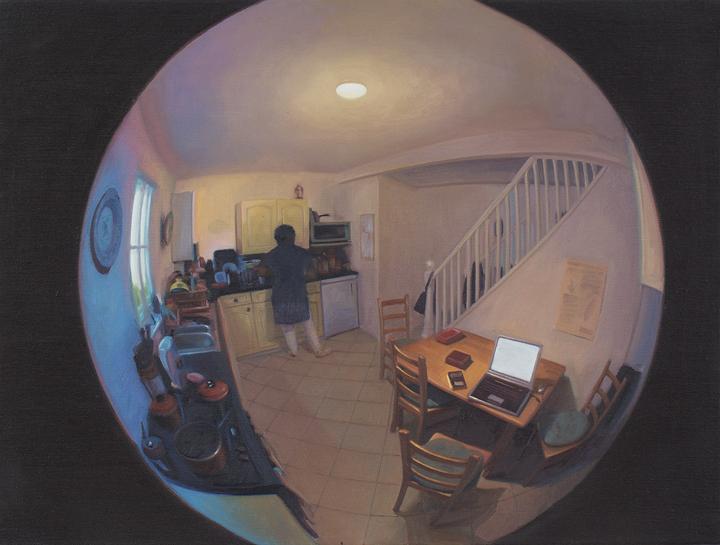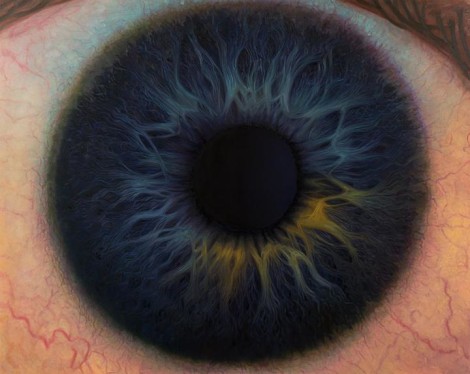Drawing a fine line between voyeurism and vigilance, Indian artist Abir Karmakar’s second solo exhibition “Uncanny Space” at Aicon Gallery continues with his preoccupation of seducing viewers to become surreptitious onlookers of his painted private spaces. Yet at the core of his presentation of empty bedrooms and intimate living areas lies the significance of invisibility. The nameless other, or the one who cannot be seen, lurks in the background, allowing the viewer to conjure upon these unseen figures his or her own human dimensions.
In Karmakar’s “Scent” (2011) series of paintings from his earlier exhibition, “The Morning After,” a slew of bedrooms come alive from the sense of intimacy one derives from the environment. Bunched up sheets, creased pillow covers, discarded clothing, and subdued lighting unleash prurient sentiments and prying eyes forbidden from outsiders. Karmakar invites viewers to partake of the sensuousness of the rooms, and imagine their occupants whose scent lingers through each visceral detail.
The artist presents the act of looking from a different perspective in ‘Uncanny Space.’ Here, the other takes on a more ominous aspect, and Karmakar’s focus on the actual eye through which invisibility becomes a more menacing ineffable presence is explored. Situated behind the foyer, four spectacular paintings of magnified eyes loom large in the cavernous space of the gallery. Labeled Sun 1–IV (2015), these volcanic abstractions of enlarged pupils and iridescent irises accost the viewer on first encounter. While each pupil resembles a dark foreboding abyss, the fibrous aqua blue, orange and brown protrusions from each iris emanate powerful rays like the sun. The surrounding pink sclera of the eye is filled with bright red squiggly capillaries. But what does one make of these huge oval painted shapes that are as radiant as they are oppressive, and as seductive as they are repulsive? Ostensibly, each Sun, i.e. the eye, serves as the first point of entry for all data, and the point at which all understanding begins. It is through the eye that observations are made, and through one’s gaze that invisible persons are fantasized or demonized as one keeps vigilance from a distance.
Hung directly opposite and adjacent to the dazzling “Sun” series, are groups of much smaller paintings titled Angle I–VI, 2015, and View I–IV, 2015. Mimicking images mostly viewed through binoculars, and some keyholes, these mundane scenes of living rooms and bedrooms, no different than those from a surveillance camera, lack the tactility and pleasure-seeking aura of the “Scent” paintings. Set at a distance from the viewer, austere living rooms without a trace of inhabitance in the “Angle” series appear with rounded walls and askew edges that are compromised by the tilt of the telescopic lens. Pince-nez images of bedrooms and bathrooms filled with personal belongings in the “View” series seem very ordinary. However, despite the unfulfilling activity of peering into these areas, “there is an air of expectation,” as Donald Kuspit notes in his catalog essay. One can’t help but begin to ascribe meaning to the sterile environment of the invisible inhabitant whose folded clothes on the bed and toiletries in the bathroom become trapped in the ominous world of the binoculars and the keyhole.
Karmakar’s trajectory from his alluring paintings that were suffused with suggestion and engagement to images of disengaged undesirability implies a significant shift and ambivalence about the act of looking. These purposefully negligible paintings of barren rooms in the post Snowden era make one question the value of visual eavesdropping. The works prod us to query if one really understands or gains knowledge about people from aimless scrutiny of unoccupied spaces. By removing the voyeuristic thrill of his earlier works, the voyeur turned vigilante in Uncanny Space seems to uphold the view that surveillance could lead to pointless conjecture. In contrast, the portentous sequence of eyes serves as powerful signifiers to open one’s mind to the idea of assigning meaning to unseen people. Most importantly, the eyes in the show stand out not just by scale but also by magnifying the conflict of invisibility.
Abir Karmakar: Uncanny Space
AICON GALLERY, NEW YORK
35 Great Jones Street
New York, NY 10012
Ends September 5, 2015





